Business Operations Management Report: Samsung Company Analysis
VerifiedAdded on 2023/05/27
|11
|2287
|324
Report
AI Summary
This report provides a comprehensive analysis of Samsung's business operations. It begins with an overview of Samsung's background, including its purpose, size, competitors, target customers, and recent performance. The report then delves into the company's transformation processes, evaluating its operations management using the four Vs (Volume, Variety, Variation, and Visibility) and assessing its performance objectives such as quality, speed, flexibility, dependability, and cost. Finally, the report identifies key organizational processes, including the flow of customers, materials, and information, and discusses the objectives of the design process. The analysis highlights operational issues and suggests implementations of control and feedback mechanisms to improve Samsung's overall performance. The report concludes with a summary of the findings and their implications for Samsung's future operations.
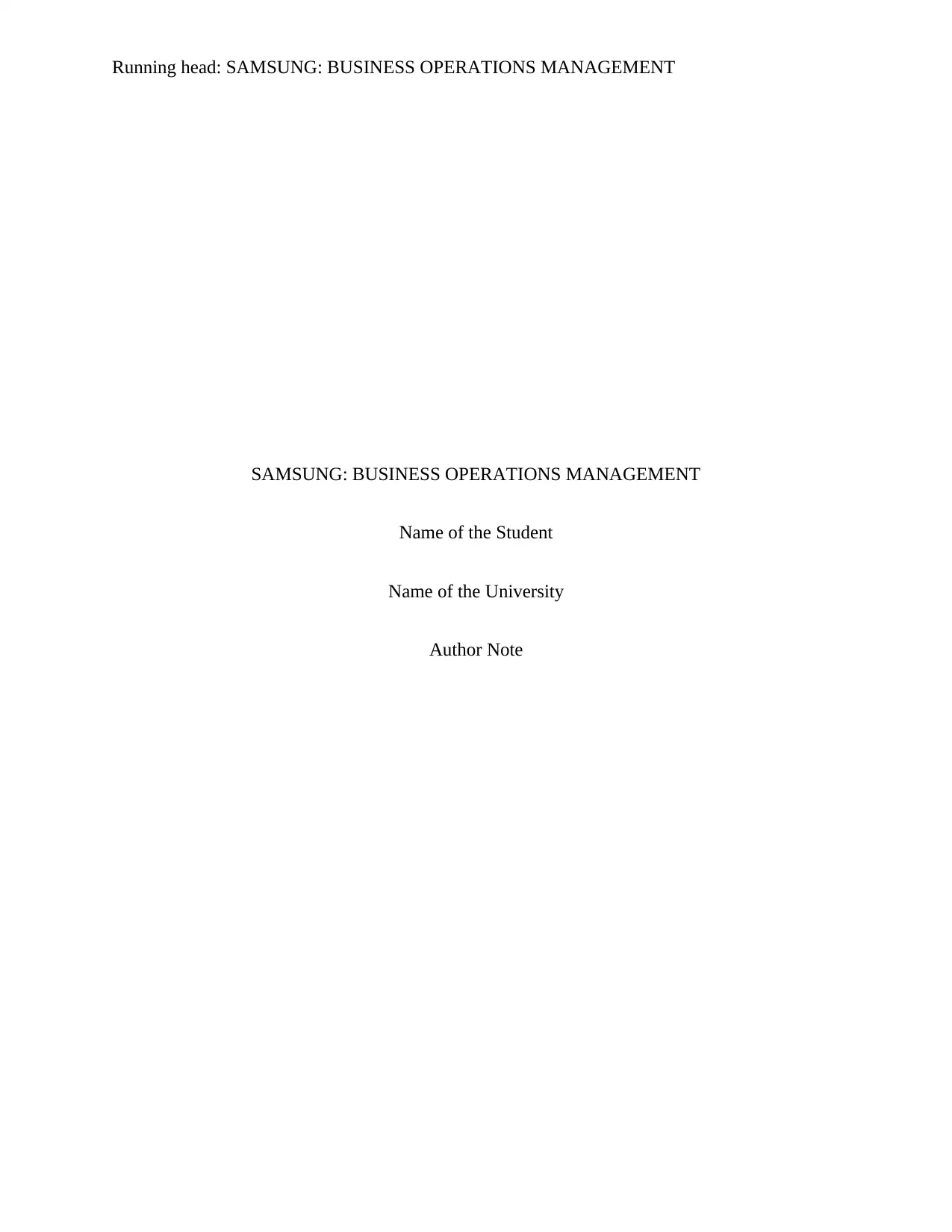
Running head: SAMSUNG: BUSINESS OPERATIONS MANAGEMENT
SAMSUNG: BUSINESS OPERATIONS MANAGEMENT
Name of the Student
Name of the University
Author Note
SAMSUNG: BUSINESS OPERATIONS MANAGEMENT
Name of the Student
Name of the University
Author Note
Paraphrase This Document
Need a fresh take? Get an instant paraphrase of this document with our AI Paraphraser
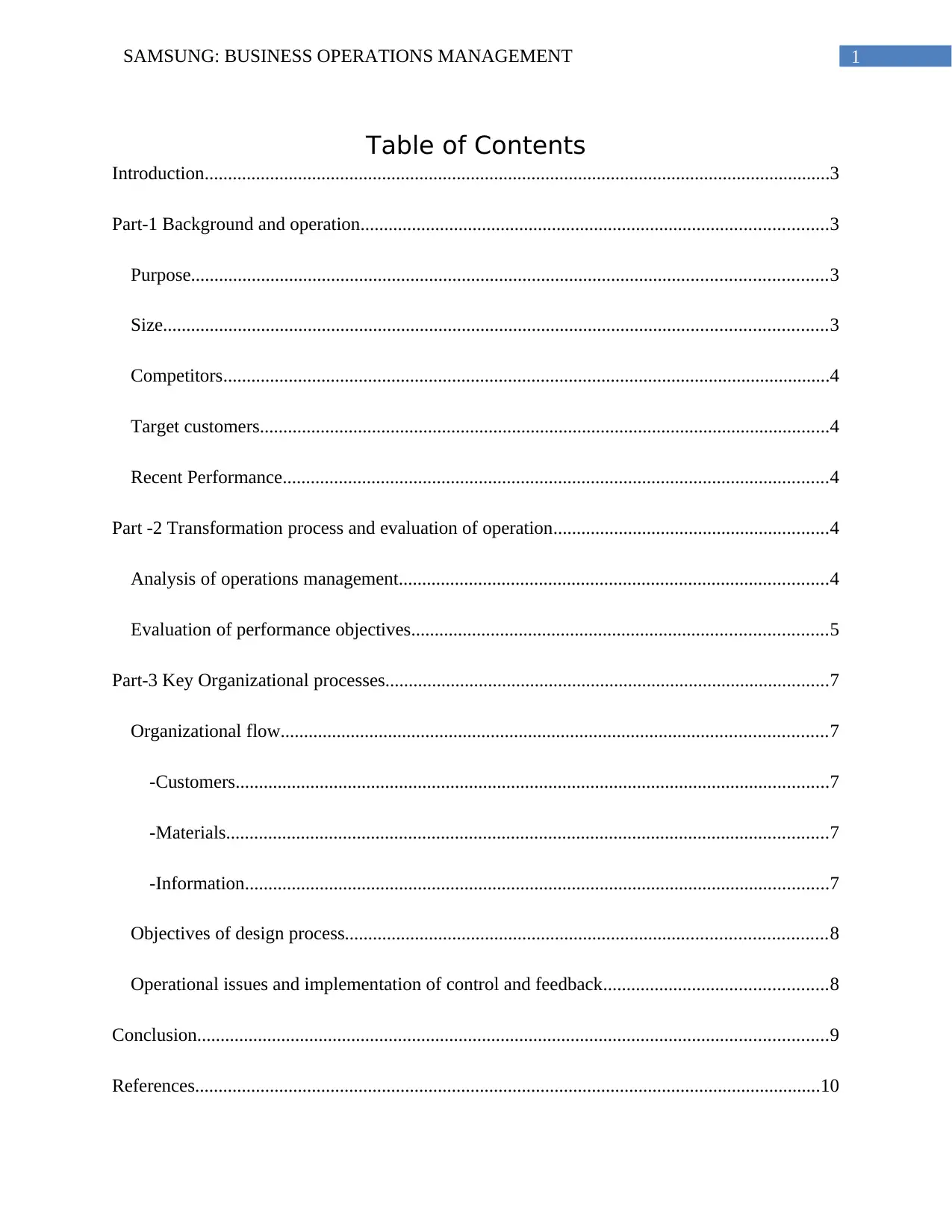
1SAMSUNG: BUSINESS OPERATIONS MANAGEMENT
Table of Contents
Introduction......................................................................................................................................3
Part-1 Background and operation....................................................................................................3
Purpose........................................................................................................................................3
Size..............................................................................................................................................3
Competitors..................................................................................................................................4
Target customers..........................................................................................................................4
Recent Performance.....................................................................................................................4
Part -2 Transformation process and evaluation of operation...........................................................4
Analysis of operations management............................................................................................4
Evaluation of performance objectives.........................................................................................5
Part-3 Key Organizational processes...............................................................................................7
Organizational flow.....................................................................................................................7
-Customers...............................................................................................................................7
-Materials.................................................................................................................................7
-Information.............................................................................................................................7
Objectives of design process.......................................................................................................8
Operational issues and implementation of control and feedback................................................8
Conclusion.......................................................................................................................................9
References......................................................................................................................................10
Table of Contents
Introduction......................................................................................................................................3
Part-1 Background and operation....................................................................................................3
Purpose........................................................................................................................................3
Size..............................................................................................................................................3
Competitors..................................................................................................................................4
Target customers..........................................................................................................................4
Recent Performance.....................................................................................................................4
Part -2 Transformation process and evaluation of operation...........................................................4
Analysis of operations management............................................................................................4
Evaluation of performance objectives.........................................................................................5
Part-3 Key Organizational processes...............................................................................................7
Organizational flow.....................................................................................................................7
-Customers...............................................................................................................................7
-Materials.................................................................................................................................7
-Information.............................................................................................................................7
Objectives of design process.......................................................................................................8
Operational issues and implementation of control and feedback................................................8
Conclusion.......................................................................................................................................9
References......................................................................................................................................10

2SAMSUNG: BUSINESS OPERATIONS MANAGEMENT
⊘ This is a preview!⊘
Do you want full access?
Subscribe today to unlock all pages.

Trusted by 1+ million students worldwide
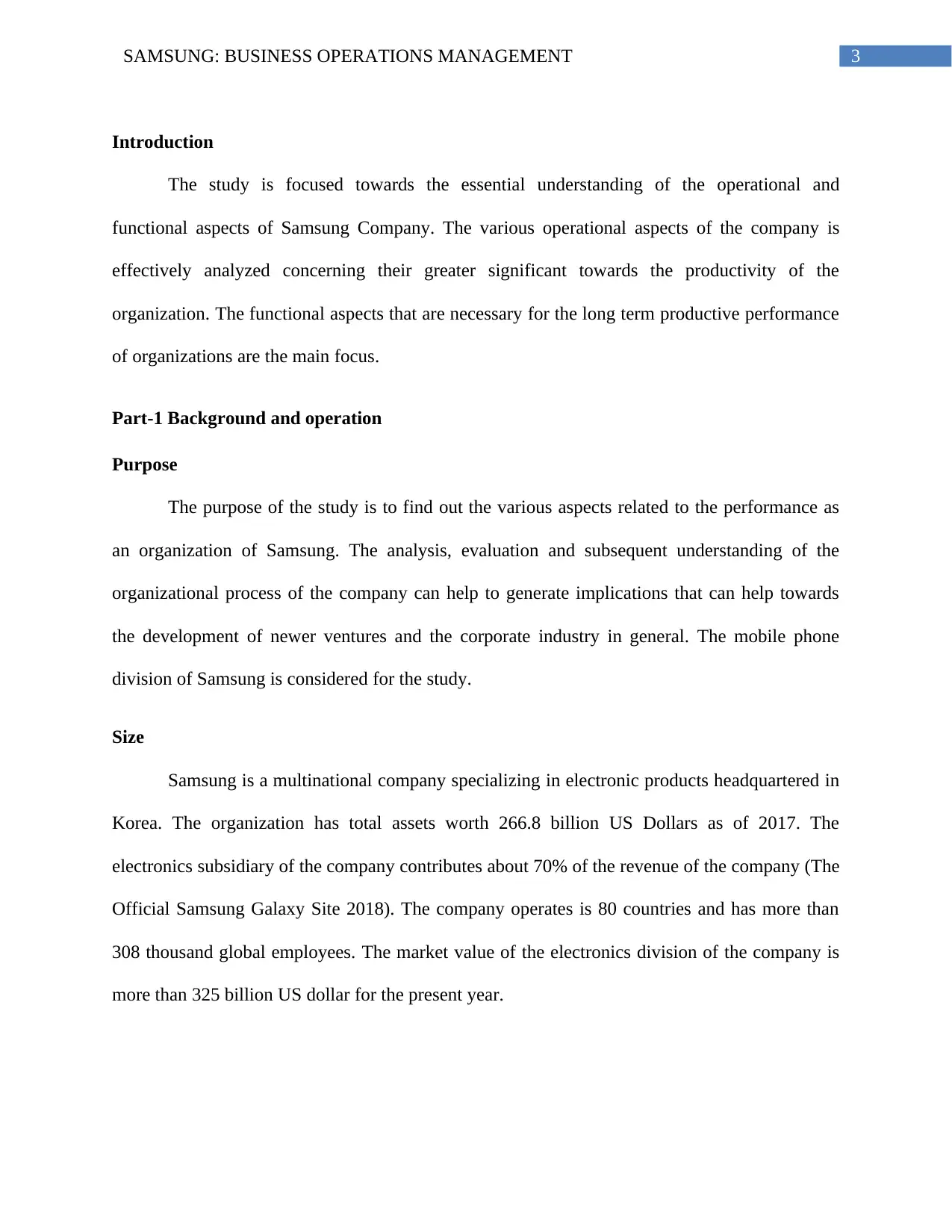
3SAMSUNG: BUSINESS OPERATIONS MANAGEMENT
Introduction
The study is focused towards the essential understanding of the operational and
functional aspects of Samsung Company. The various operational aspects of the company is
effectively analyzed concerning their greater significant towards the productivity of the
organization. The functional aspects that are necessary for the long term productive performance
of organizations are the main focus.
Part-1 Background and operation
Purpose
The purpose of the study is to find out the various aspects related to the performance as
an organization of Samsung. The analysis, evaluation and subsequent understanding of the
organizational process of the company can help to generate implications that can help towards
the development of newer ventures and the corporate industry in general. The mobile phone
division of Samsung is considered for the study.
Size
Samsung is a multinational company specializing in electronic products headquartered in
Korea. The organization has total assets worth 266.8 billion US Dollars as of 2017. The
electronics subsidiary of the company contributes about 70% of the revenue of the company (The
Official Samsung Galaxy Site 2018). The company operates is 80 countries and has more than
308 thousand global employees. The market value of the electronics division of the company is
more than 325 billion US dollar for the present year.
Introduction
The study is focused towards the essential understanding of the operational and
functional aspects of Samsung Company. The various operational aspects of the company is
effectively analyzed concerning their greater significant towards the productivity of the
organization. The functional aspects that are necessary for the long term productive performance
of organizations are the main focus.
Part-1 Background and operation
Purpose
The purpose of the study is to find out the various aspects related to the performance as
an organization of Samsung. The analysis, evaluation and subsequent understanding of the
organizational process of the company can help to generate implications that can help towards
the development of newer ventures and the corporate industry in general. The mobile phone
division of Samsung is considered for the study.
Size
Samsung is a multinational company specializing in electronic products headquartered in
Korea. The organization has total assets worth 266.8 billion US Dollars as of 2017. The
electronics subsidiary of the company contributes about 70% of the revenue of the company (The
Official Samsung Galaxy Site 2018). The company operates is 80 countries and has more than
308 thousand global employees. The market value of the electronics division of the company is
more than 325 billion US dollar for the present year.
Paraphrase This Document
Need a fresh take? Get an instant paraphrase of this document with our AI Paraphraser
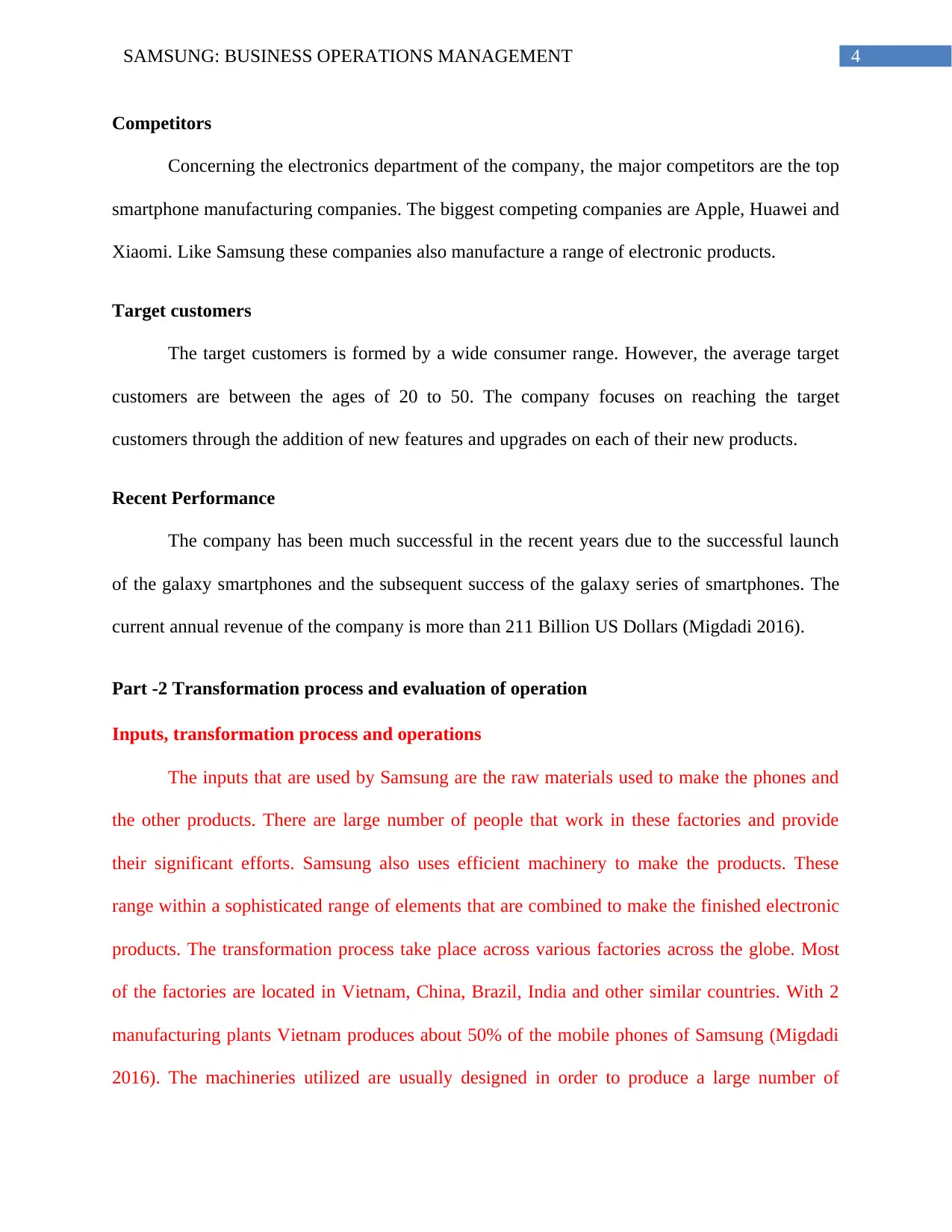
4SAMSUNG: BUSINESS OPERATIONS MANAGEMENT
Competitors
Concerning the electronics department of the company, the major competitors are the top
smartphone manufacturing companies. The biggest competing companies are Apple, Huawei and
Xiaomi. Like Samsung these companies also manufacture a range of electronic products.
Target customers
The target customers is formed by a wide consumer range. However, the average target
customers are between the ages of 20 to 50. The company focuses on reaching the target
customers through the addition of new features and upgrades on each of their new products.
Recent Performance
The company has been much successful in the recent years due to the successful launch
of the galaxy smartphones and the subsequent success of the galaxy series of smartphones. The
current annual revenue of the company is more than 211 Billion US Dollars (Migdadi 2016).
Part -2 Transformation process and evaluation of operation
Inputs, transformation process and operations
The inputs that are used by Samsung are the raw materials used to make the phones and
the other products. There are large number of people that work in these factories and provide
their significant efforts. Samsung also uses efficient machinery to make the products. These
range within a sophisticated range of elements that are combined to make the finished electronic
products. The transformation process take place across various factories across the globe. Most
of the factories are located in Vietnam, China, Brazil, India and other similar countries. With 2
manufacturing plants Vietnam produces about 50% of the mobile phones of Samsung (Migdadi
2016). The machineries utilized are usually designed in order to produce a large number of
Competitors
Concerning the electronics department of the company, the major competitors are the top
smartphone manufacturing companies. The biggest competing companies are Apple, Huawei and
Xiaomi. Like Samsung these companies also manufacture a range of electronic products.
Target customers
The target customers is formed by a wide consumer range. However, the average target
customers are between the ages of 20 to 50. The company focuses on reaching the target
customers through the addition of new features and upgrades on each of their new products.
Recent Performance
The company has been much successful in the recent years due to the successful launch
of the galaxy smartphones and the subsequent success of the galaxy series of smartphones. The
current annual revenue of the company is more than 211 Billion US Dollars (Migdadi 2016).
Part -2 Transformation process and evaluation of operation
Inputs, transformation process and operations
The inputs that are used by Samsung are the raw materials used to make the phones and
the other products. There are large number of people that work in these factories and provide
their significant efforts. Samsung also uses efficient machinery to make the products. These
range within a sophisticated range of elements that are combined to make the finished electronic
products. The transformation process take place across various factories across the globe. Most
of the factories are located in Vietnam, China, Brazil, India and other similar countries. With 2
manufacturing plants Vietnam produces about 50% of the mobile phones of Samsung (Migdadi
2016). The machineries utilized are usually designed in order to produce a large number of

5SAMSUNG: BUSINESS OPERATIONS MANAGEMENT
different electronic products. The various parts are made and transferred to specific departments
where they are assembled to make the finished products. The outputs are the finished goods that
reach the customers. Vietnam alone produces 240 million units of Samsung phones. Considering
the mobile phones Samsung produces around 120 million phones each year (The Official
Samsung Galaxy Site 2018).
Analysis of operations management
The organization in terms of the four Vs of operations management are:-
Volume- The volume of operations of Samsung is low. They undertake operations for the
effective production of a large number of smartphones. Hence, the volume of production of the
company is significantly large (Hitt, Xu and Carnes 2016). The company has dominated the
market for a long time due to their operational low volume. The company has recently sold more
than 73 million phones worldwide. The operational features of the company have been greatly
systematized for providing maximum productivity.
Variety- the Company offers a variety of products for the customers. The organization has to
hence take part in great variety of operations to cater to the demand of their large variety of
offered products. The company has to cater to the requirements of a large number of customers.
They have a large number of smartphones that have various levels of specifications. This is the
reason behind the company taking part in a large number of operational functions.
Variation- The change in demand of the products of company happen quite often. The Samsung
galaxy series phones are very much in demand and new versions are released to keep up with the
market competition in course of few months (Bozarth and Handfield 2018). There are various
different electronic products. The various parts are made and transferred to specific departments
where they are assembled to make the finished products. The outputs are the finished goods that
reach the customers. Vietnam alone produces 240 million units of Samsung phones. Considering
the mobile phones Samsung produces around 120 million phones each year (The Official
Samsung Galaxy Site 2018).
Analysis of operations management
The organization in terms of the four Vs of operations management are:-
Volume- The volume of operations of Samsung is low. They undertake operations for the
effective production of a large number of smartphones. Hence, the volume of production of the
company is significantly large (Hitt, Xu and Carnes 2016). The company has dominated the
market for a long time due to their operational low volume. The company has recently sold more
than 73 million phones worldwide. The operational features of the company have been greatly
systematized for providing maximum productivity.
Variety- the Company offers a variety of products for the customers. The organization has to
hence take part in great variety of operations to cater to the demand of their large variety of
offered products. The company has to cater to the requirements of a large number of customers.
They have a large number of smartphones that have various levels of specifications. This is the
reason behind the company taking part in a large number of operational functions.
Variation- The change in demand of the products of company happen quite often. The Samsung
galaxy series phones are very much in demand and new versions are released to keep up with the
market competition in course of few months (Bozarth and Handfield 2018). There are various
⊘ This is a preview!⊘
Do you want full access?
Subscribe today to unlock all pages.

Trusted by 1+ million students worldwide
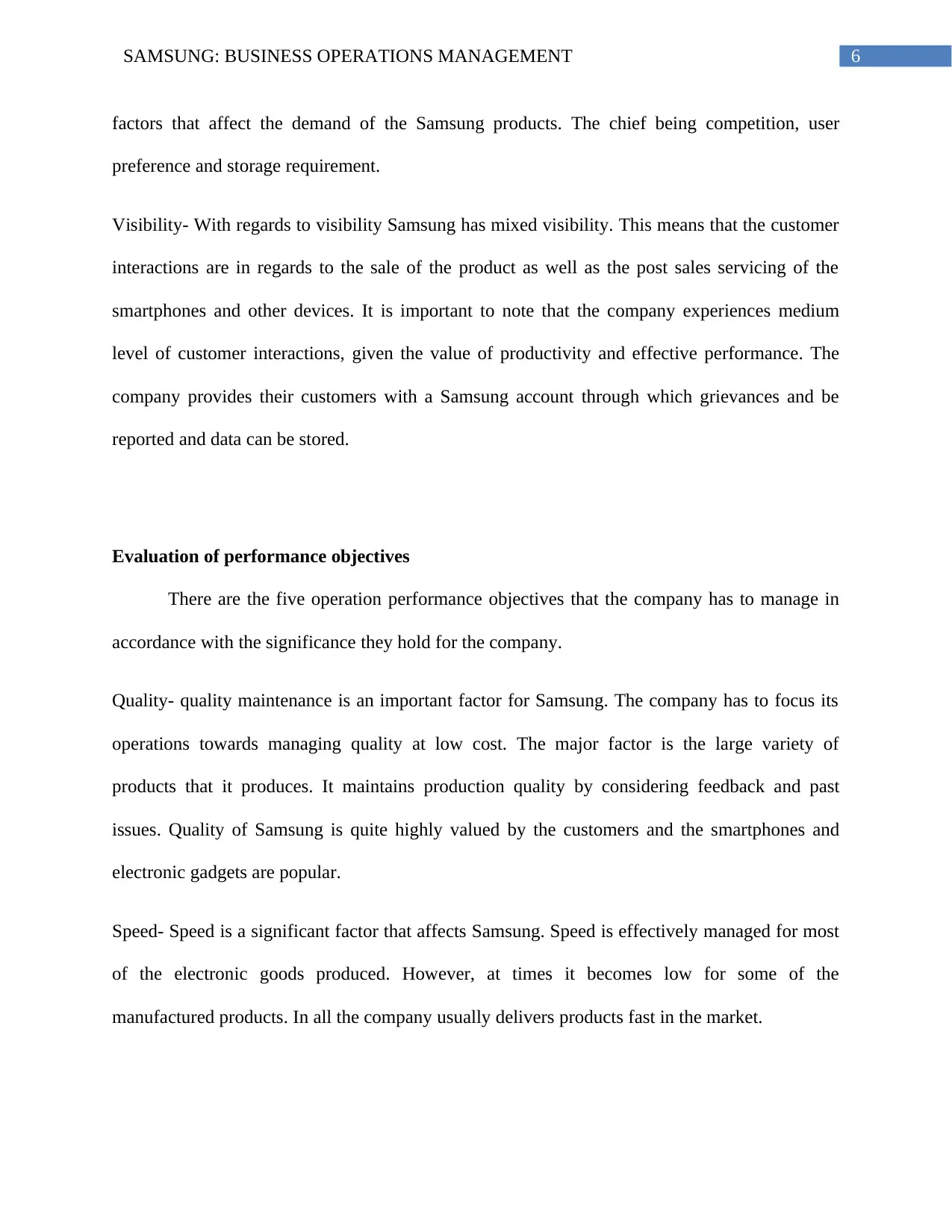
6SAMSUNG: BUSINESS OPERATIONS MANAGEMENT
factors that affect the demand of the Samsung products. The chief being competition, user
preference and storage requirement.
Visibility- With regards to visibility Samsung has mixed visibility. This means that the customer
interactions are in regards to the sale of the product as well as the post sales servicing of the
smartphones and other devices. It is important to note that the company experiences medium
level of customer interactions, given the value of productivity and effective performance. The
company provides their customers with a Samsung account through which grievances and be
reported and data can be stored.
Evaluation of performance objectives
There are the five operation performance objectives that the company has to manage in
accordance with the significance they hold for the company.
Quality- quality maintenance is an important factor for Samsung. The company has to focus its
operations towards managing quality at low cost. The major factor is the large variety of
products that it produces. It maintains production quality by considering feedback and past
issues. Quality of Samsung is quite highly valued by the customers and the smartphones and
electronic gadgets are popular.
Speed- Speed is a significant factor that affects Samsung. Speed is effectively managed for most
of the electronic goods produced. However, at times it becomes low for some of the
manufactured products. In all the company usually delivers products fast in the market.
factors that affect the demand of the Samsung products. The chief being competition, user
preference and storage requirement.
Visibility- With regards to visibility Samsung has mixed visibility. This means that the customer
interactions are in regards to the sale of the product as well as the post sales servicing of the
smartphones and other devices. It is important to note that the company experiences medium
level of customer interactions, given the value of productivity and effective performance. The
company provides their customers with a Samsung account through which grievances and be
reported and data can be stored.
Evaluation of performance objectives
There are the five operation performance objectives that the company has to manage in
accordance with the significance they hold for the company.
Quality- quality maintenance is an important factor for Samsung. The company has to focus its
operations towards managing quality at low cost. The major factor is the large variety of
products that it produces. It maintains production quality by considering feedback and past
issues. Quality of Samsung is quite highly valued by the customers and the smartphones and
electronic gadgets are popular.
Speed- Speed is a significant factor that affects Samsung. Speed is effectively managed for most
of the electronic goods produced. However, at times it becomes low for some of the
manufactured products. In all the company usually delivers products fast in the market.
Paraphrase This Document
Need a fresh take? Get an instant paraphrase of this document with our AI Paraphraser

7SAMSUNG: BUSINESS OPERATIONS MANAGEMENT
Flexibility- Flexibility is very important for the company. The electronics subdivision of the
company has to live up to the changing technological factors of the market and consumer
demand. The smartphone production is one of the most flexible operations of the company.
Dependability- This is a factor that the company is striving towards achieving. The dependability
of the company has been fluctuating over the years especially with regard to its smartphone. The
company has recently focuses towards better delivery. This has helped the company to
significantly improve and increase customer satisfaction. Samsung provides great importance to
the provision of products to customers at the right time.
Cost- The cost of the products are reasonably lower than many of the competitors. The product
variety is large, hence, the volume tends to be low to certain extent (Migdadi 2016). The
company does not treat this as a huge factor. This is mainly because there is significant demand
for both the higher priced and lower priced products of the company.
Part-3 Key Organizational processes
Organizational flow
-Customers
The flow of customers is significant for the company. The electronic devices of the
company are sold through both the Samsung stores and also the various multi-product oriented
stores. The company usually relies on the dedicated Samsung stores for catering to the customer
demand. A large part of the smartphone sales for the company currently happens online. The
online customer base of Samsung has increased substantially.
Flexibility- Flexibility is very important for the company. The electronics subdivision of the
company has to live up to the changing technological factors of the market and consumer
demand. The smartphone production is one of the most flexible operations of the company.
Dependability- This is a factor that the company is striving towards achieving. The dependability
of the company has been fluctuating over the years especially with regard to its smartphone. The
company has recently focuses towards better delivery. This has helped the company to
significantly improve and increase customer satisfaction. Samsung provides great importance to
the provision of products to customers at the right time.
Cost- The cost of the products are reasonably lower than many of the competitors. The product
variety is large, hence, the volume tends to be low to certain extent (Migdadi 2016). The
company does not treat this as a huge factor. This is mainly because there is significant demand
for both the higher priced and lower priced products of the company.
Part-3 Key Organizational processes
Organizational flow
-Customers
The flow of customers is significant for the company. The electronic devices of the
company are sold through both the Samsung stores and also the various multi-product oriented
stores. The company usually relies on the dedicated Samsung stores for catering to the customer
demand. A large part of the smartphone sales for the company currently happens online. The
online customer base of Samsung has increased substantially.
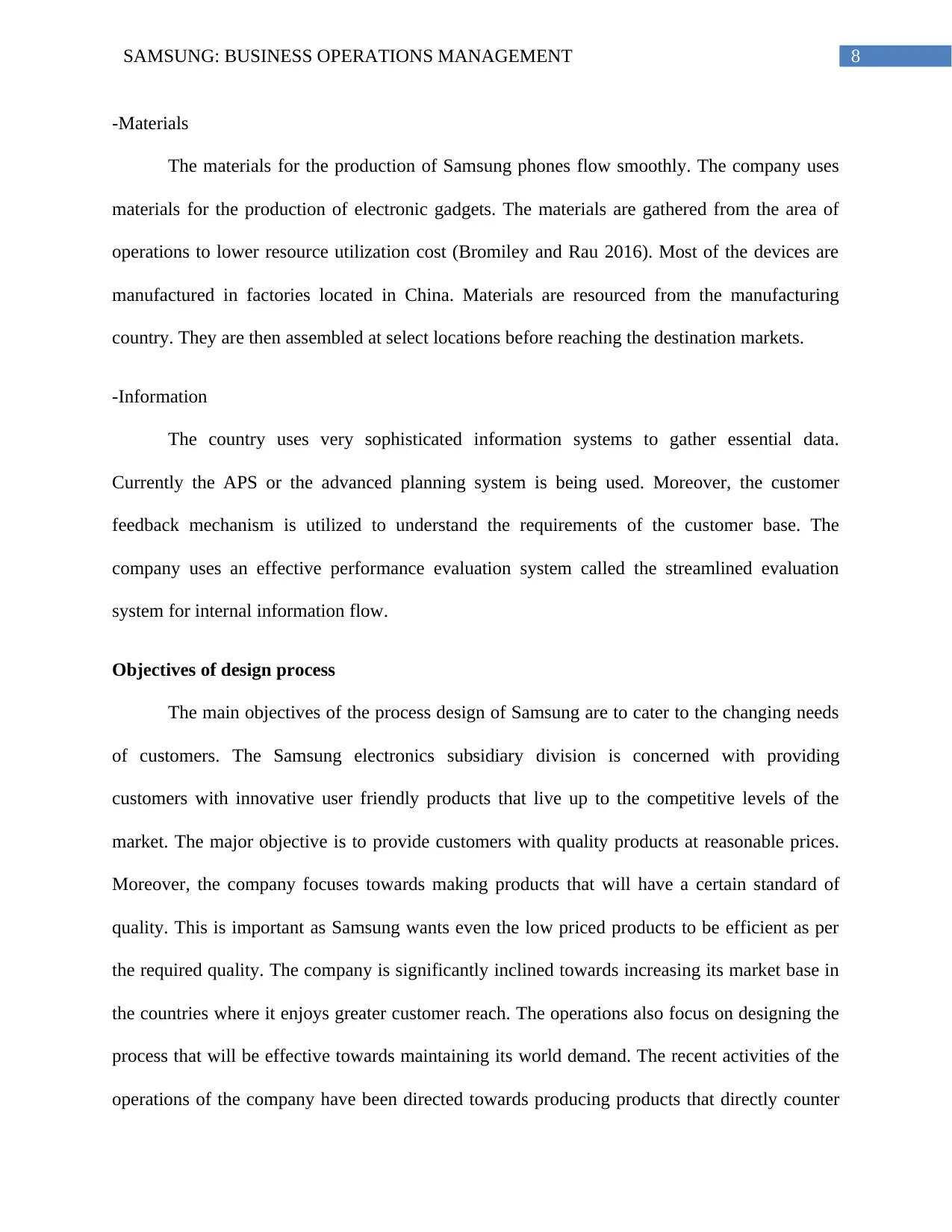
8SAMSUNG: BUSINESS OPERATIONS MANAGEMENT
-Materials
The materials for the production of Samsung phones flow smoothly. The company uses
materials for the production of electronic gadgets. The materials are gathered from the area of
operations to lower resource utilization cost (Bromiley and Rau 2016). Most of the devices are
manufactured in factories located in China. Materials are resourced from the manufacturing
country. They are then assembled at select locations before reaching the destination markets.
-Information
The country uses very sophisticated information systems to gather essential data.
Currently the APS or the advanced planning system is being used. Moreover, the customer
feedback mechanism is utilized to understand the requirements of the customer base. The
company uses an effective performance evaluation system called the streamlined evaluation
system for internal information flow.
Objectives of design process
The main objectives of the process design of Samsung are to cater to the changing needs
of customers. The Samsung electronics subsidiary division is concerned with providing
customers with innovative user friendly products that live up to the competitive levels of the
market. The major objective is to provide customers with quality products at reasonable prices.
Moreover, the company focuses towards making products that will have a certain standard of
quality. This is important as Samsung wants even the low priced products to be efficient as per
the required quality. The company is significantly inclined towards increasing its market base in
the countries where it enjoys greater customer reach. The operations also focus on designing the
process that will be effective towards maintaining its world demand. The recent activities of the
operations of the company have been directed towards producing products that directly counter
-Materials
The materials for the production of Samsung phones flow smoothly. The company uses
materials for the production of electronic gadgets. The materials are gathered from the area of
operations to lower resource utilization cost (Bromiley and Rau 2016). Most of the devices are
manufactured in factories located in China. Materials are resourced from the manufacturing
country. They are then assembled at select locations before reaching the destination markets.
-Information
The country uses very sophisticated information systems to gather essential data.
Currently the APS or the advanced planning system is being used. Moreover, the customer
feedback mechanism is utilized to understand the requirements of the customer base. The
company uses an effective performance evaluation system called the streamlined evaluation
system for internal information flow.
Objectives of design process
The main objectives of the process design of Samsung are to cater to the changing needs
of customers. The Samsung electronics subsidiary division is concerned with providing
customers with innovative user friendly products that live up to the competitive levels of the
market. The major objective is to provide customers with quality products at reasonable prices.
Moreover, the company focuses towards making products that will have a certain standard of
quality. This is important as Samsung wants even the low priced products to be efficient as per
the required quality. The company is significantly inclined towards increasing its market base in
the countries where it enjoys greater customer reach. The operations also focus on designing the
process that will be effective towards maintaining its world demand. The recent activities of the
operations of the company have been directed towards producing products that directly counter
⊘ This is a preview!⊘
Do you want full access?
Subscribe today to unlock all pages.

Trusted by 1+ million students worldwide

9SAMSUNG: BUSINESS OPERATIONS MANAGEMENT
the specializations of the competitors. The production of high end smartphones have been done
in a way to directly compete with the iphone (Migdadi 2016). The operations are also focused
towards increasing the volume of products at specific markets.
Operational issues and implementation of control and feedback
One of the significant issues that have been identified with the operations of Samsung is
its relative ineffectiveness while producing smartphones to challenge the emergence of the new
mobiles. The middle range smartphones being produced by companies such as Xiaomi are
dominating the market. Moreover, the non-phone devices manufactured by the company are not
being able to live up to the expectation of the customer base. Hence, product specialization of the
company with regards to smartphones are affecting the market demand of its other electronic
products (Anand and Gray 2017). Customer feedback and control mechanisms can be greatly
used to improve the operations of the company. Customer feedback can be used in order to gain
better knowledge about customer preferences since this is also a significant objective of the
production process of the company (Migdadi 2016).
Conclusion
In conclusion, it can be said that the production process of Samsung is relatively stable.
However, the operations need to be greatly optimized for living up to the expectations of the
future customers. The operations of the company need to be changed significantly towards
realizing better opportunities in the future.
the specializations of the competitors. The production of high end smartphones have been done
in a way to directly compete with the iphone (Migdadi 2016). The operations are also focused
towards increasing the volume of products at specific markets.
Operational issues and implementation of control and feedback
One of the significant issues that have been identified with the operations of Samsung is
its relative ineffectiveness while producing smartphones to challenge the emergence of the new
mobiles. The middle range smartphones being produced by companies such as Xiaomi are
dominating the market. Moreover, the non-phone devices manufactured by the company are not
being able to live up to the expectation of the customer base. Hence, product specialization of the
company with regards to smartphones are affecting the market demand of its other electronic
products (Anand and Gray 2017). Customer feedback and control mechanisms can be greatly
used to improve the operations of the company. Customer feedback can be used in order to gain
better knowledge about customer preferences since this is also a significant objective of the
production process of the company (Migdadi 2016).
Conclusion
In conclusion, it can be said that the production process of Samsung is relatively stable.
However, the operations need to be greatly optimized for living up to the expectations of the
future customers. The operations of the company need to be changed significantly towards
realizing better opportunities in the future.
Paraphrase This Document
Need a fresh take? Get an instant paraphrase of this document with our AI Paraphraser
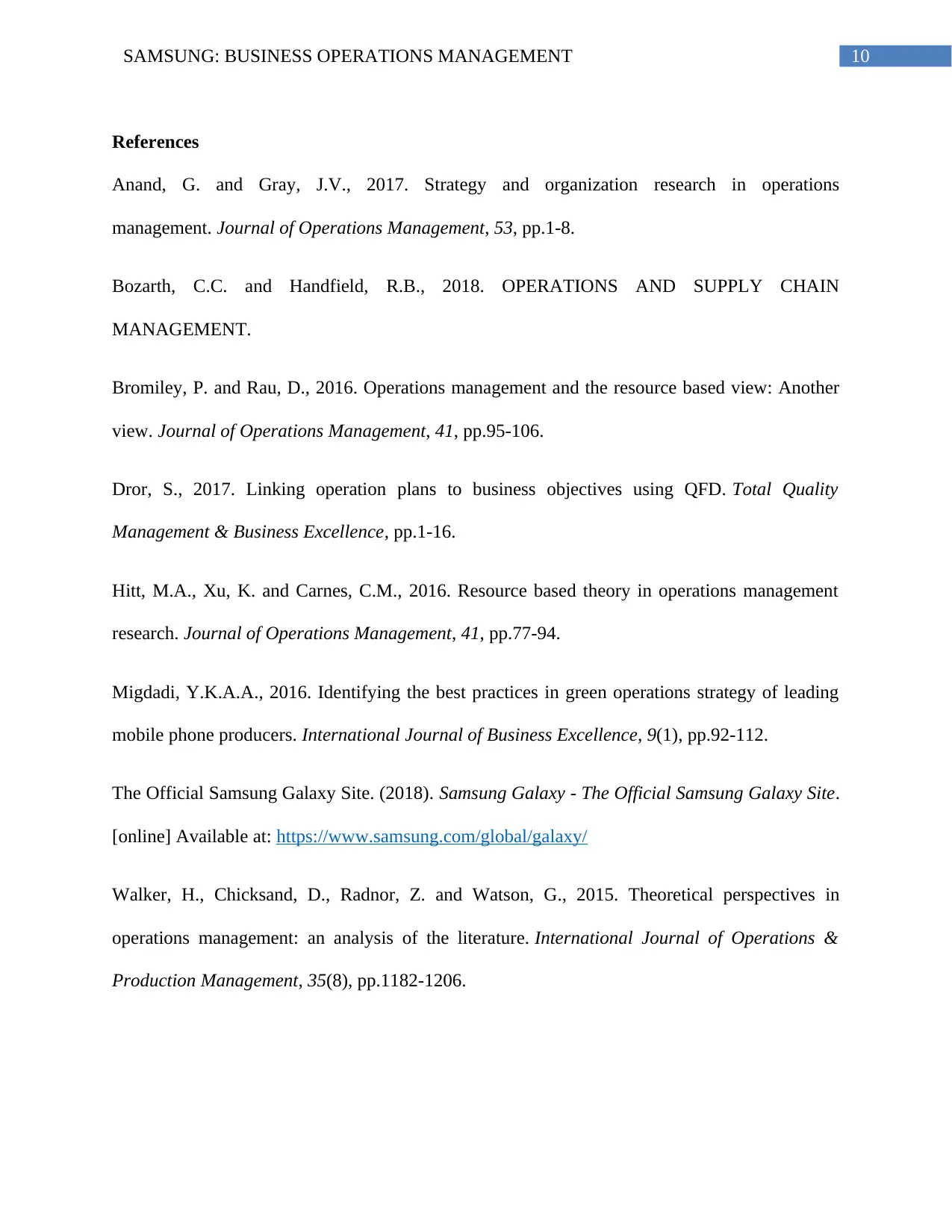
10SAMSUNG: BUSINESS OPERATIONS MANAGEMENT
References
Anand, G. and Gray, J.V., 2017. Strategy and organization research in operations
management. Journal of Operations Management, 53, pp.1-8.
Bozarth, C.C. and Handfield, R.B., 2018. OPERATIONS AND SUPPLY CHAIN
MANAGEMENT.
Bromiley, P. and Rau, D., 2016. Operations management and the resource based view: Another
view. Journal of Operations Management, 41, pp.95-106.
Dror, S., 2017. Linking operation plans to business objectives using QFD. Total Quality
Management & Business Excellence, pp.1-16.
Hitt, M.A., Xu, K. and Carnes, C.M., 2016. Resource based theory in operations management
research. Journal of Operations Management, 41, pp.77-94.
Migdadi, Y.K.A.A., 2016. Identifying the best practices in green operations strategy of leading
mobile phone producers. International Journal of Business Excellence, 9(1), pp.92-112.
The Official Samsung Galaxy Site. (2018). Samsung Galaxy - The Official Samsung Galaxy Site.
[online] Available at: https://www.samsung.com/global/galaxy/
Walker, H., Chicksand, D., Radnor, Z. and Watson, G., 2015. Theoretical perspectives in
operations management: an analysis of the literature. International Journal of Operations &
Production Management, 35(8), pp.1182-1206.
References
Anand, G. and Gray, J.V., 2017. Strategy and organization research in operations
management. Journal of Operations Management, 53, pp.1-8.
Bozarth, C.C. and Handfield, R.B., 2018. OPERATIONS AND SUPPLY CHAIN
MANAGEMENT.
Bromiley, P. and Rau, D., 2016. Operations management and the resource based view: Another
view. Journal of Operations Management, 41, pp.95-106.
Dror, S., 2017. Linking operation plans to business objectives using QFD. Total Quality
Management & Business Excellence, pp.1-16.
Hitt, M.A., Xu, K. and Carnes, C.M., 2016. Resource based theory in operations management
research. Journal of Operations Management, 41, pp.77-94.
Migdadi, Y.K.A.A., 2016. Identifying the best practices in green operations strategy of leading
mobile phone producers. International Journal of Business Excellence, 9(1), pp.92-112.
The Official Samsung Galaxy Site. (2018). Samsung Galaxy - The Official Samsung Galaxy Site.
[online] Available at: https://www.samsung.com/global/galaxy/
Walker, H., Chicksand, D., Radnor, Z. and Watson, G., 2015. Theoretical perspectives in
operations management: an analysis of the literature. International Journal of Operations &
Production Management, 35(8), pp.1182-1206.
1 out of 11
Related Documents
Your All-in-One AI-Powered Toolkit for Academic Success.
+13062052269
info@desklib.com
Available 24*7 on WhatsApp / Email
![[object Object]](/_next/static/media/star-bottom.7253800d.svg)
Unlock your academic potential
Copyright © 2020–2025 A2Z Services. All Rights Reserved. Developed and managed by ZUCOL.





